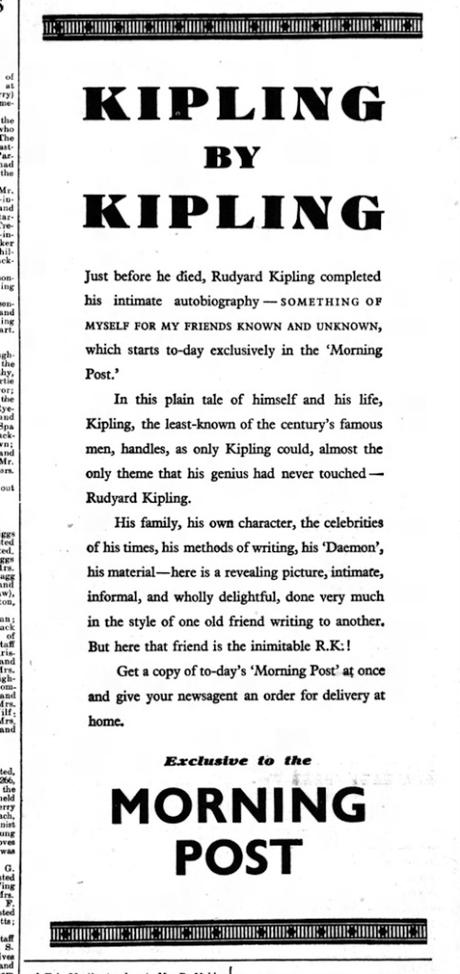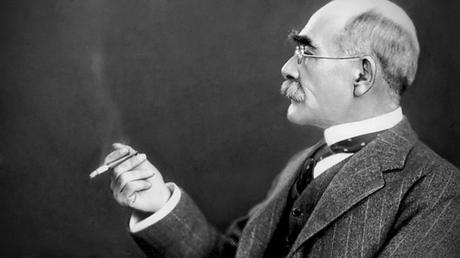Book Review by George S: Kipling began writing this autobiography in August 1935, and worked on it intermittently during the five months before his death in January 1936. The finished chapters are fascinating, but tantalisingly incomplete; after his death they were edited for publication by his strong-minded wife, Carrie, who organised the material, and maybe censored it, too.
Kipling was a complicated man, and a reticent one, and the book is in many areas unrevealing. There are huge gaps. One of the most interesting of Kipling's relationships is with Woolcott Balestier, with whom he wrote a novel and went to live in Canada. It was after Balestier's death that Kipling married Carrie; There is nothing of this in Something of Myself, which leaps from a chapter about Kipling's life in London as a young writer to one in which he is already married. Nor does the book deal with the most difficult times in Kipling's later life - the deaths of his children, Josephine and John.
Despite the gaps and the reticence, it's a fascinating book. He begins with his childhood, as a loved and spoilt baby in India,
My first impression is of daybreak, light and colour and golden and purple fruits at the level of my shoulder. This would be the memory of early morning walks to the Bombay fruit market with my ayah and later with my sister in her perambulator, and of our returns with our purchases piled high on the bows of it.
From this paradise he was sent to England, following the standard custom of having children fostered away from the fevers and infections of India. He found himself in a 'small house smelling of aridity and emptiness' where he would be systematically bullied for six years.
It was an establishment run with the full vigour of the Evangelical as revealed to the Woman. I had never heard of Hell, so I was introduced to it in all its terrors [....] I was regularly beaten. The Woman had an only son of twelve or thirteen as religious as she. I was a real joy to him, for when his mother had finished with me for the day he (we slept in the same room) took me on and roasted the other side.
He suggests that the experience of tyranny was useful training for a writer: was useful for someone who would be a writer:
Nor was my life an unsuitable preparation for my future, in that it demanded constant wariness, thehabit of observation, and attendance on moods and tempers; the noting ofdiscrepancies between speech and action; a certain reserve of demeanour; and automatic suspicion of sudden favours.
The experience is told here directly and angrily, but without quite the power of his much earlier fictional treatment of it in 'Baa Baa Black Sheep' (collected in Wee Willie Winkie, 1889).
Rescued from this awful place, he is sent to school, eventually at Westward Ho in Devon. The description here fills in the background of Stalky and Co. very interestingly, but it lacks that book's intensity.
The best chapter is 'Seven years hard' about his apprenticeship on the Civil and Military Gazette in Lahore, where he, a boy just out of school, becomes half of the editorial team, and is expected to be able to write anything. He begins as a dogsbody, but becomes a writer, as his stories and poems are used to fill columns. There are hints of how he would go out walking through the bazaars and streets at night, soaking in the Indian atmosphere - but one suspects that a lot of this experience is censored. He describes how he learned to write short, and compress. He is proud of being a professional writer, not an amateur:
the difference ... between me and the vulgar herd who `write for papers' was, as I saw it, the gulf that divides the beneficed clergyman from ladies and gentlemen who contribute pumpkins and dahlias to Harvest Festival decorations.
It's when he is writing about writing that Kipling is most interesting. His artist father told him to trust his Daemon, or the instinct that tells him when a piece of writing is going to be right. He learned, he says, ' to distinguish between the peremptory motions of my Daemon, and the "carry-over" or induced electricity, which comes of what you mightcall mere "frictional" writing.'
He gives the Jungle Books, Kim, and the two Puck of Pook's Hill volumes as examples written when:
My Daemon was with me [...] and good care I took to walk delicately, lest he should withdraw. I know that he did not, because when those books were finished they said so themselves with, almost, the water-hammer click of a tap turned off.
His advice to writers is 'When your Daemon is in charge, do not try to think consciously. Drift, wait, and obey.' Is this good advice for writers. Maybe it is if you've got Kipling's talent to begin with. And possession by the Daemon does not mean you won't need to revise and improve.

There are chapters about his life in London when he returned from India and became almost impossibly famous, about South Africa and the Boer War, and a loving description of setting up house with his family at Bateman's, near Burwash.
The gaps and omissions are disappointing. If he'd lived, I'm sure he'd have written a chapter about the Great War, which so disrupted his life, and became the great theme of his writing from 1914 through to 1936.
The book is characteristically opinionated, and Kipling's prejudices are not always respectable by modern standards. There is a certain amount of settling old scores, but mostly the mood is sunny, an old man looking back on a life of achievement, blessing his luck, and being grateful for 'the fantastic cards that Fate was pleased to deal me.'

You'll learn much more about Kipling from a modern biography (I'd recommend the ones by Harry Ricketts or Charles Allen) but I enjoyed reading this, even though I felt that his Daemon was maybe only occasionally engaged while he was writing it.
